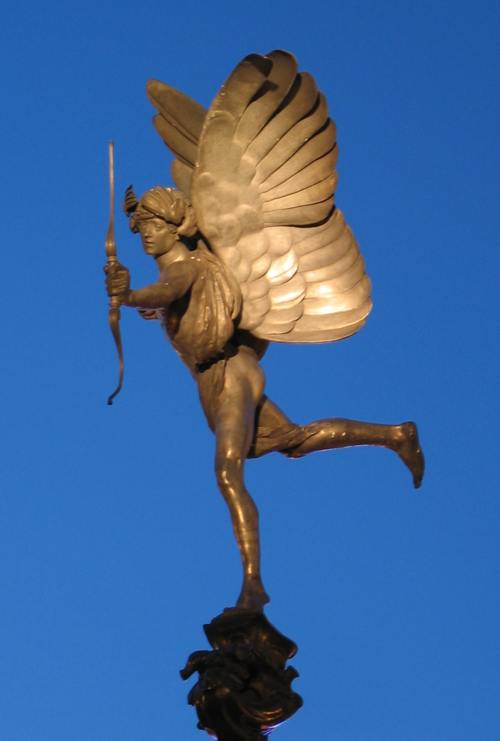Love in Reverse (original) (raw)

We all know about Cupid, especially at this time of year. His name means “desire,” and his Greek counterpart, Eros, is where we get the word “erotic.” Less familiar is his brother Anteros, intended as a companion for his lonely brother.
Picture by Kitsune64
As his name indicates, he’s sort of the opposite of Eros, which suggests that he represents hatred. Not really, though. The love that Eros stands for and inspires involves a loss of control and is often unrequited. He can be quite hostile, making it not surprising that he was sometimes viewed as the son of Ares. He sometimes makes people fall in love as a form of punishment, as he did with Apollo and Daphne. The Greeks, as you may know, had several different terms for love, four according to Wikipedia and six according to this magazine article. These include philia (brotherly love) and agape (selfless love for everybody, a term that is very popular among Christians). Anteros doesn’t symbolize anti-love so much as counter-love, or love returned. This means he’s a supporter of the mutual instead of the one-sided.
That doesn’t mean he can’t also be capricious at times, but it’s generally on a lover’s behalf. The most famous story about him appears to be that of Timagoras and Meles. The former was a foreigner in Athens who fell in love with the citizen Meles. Meles, not returning his love, sarcastically told Timagoras to jump off a rock. He did, and Meles was wracked with such guilt that he jumped off the rock as well. Anteros is said to have inspired this act on Meles’ part, and resident aliens in Athens dedicated an altar to him in honor of it. I’m not sure whether the moral is to always return love or just to let unrequited lovers down gently. There’s a statue of Anteros in Piccadilly Circus in London, a memorial of the Earl of Shaftesbury’s selfless love for the poor. It’s often mistakenly thought to be Eros himself, but you’ll notice he has butterfly wings instead of bird-like ones, perhaps the main physical difference between the two.
I think Anteros also tends to have longer hair, and sometimes carries a golden club in addition to the bow and arrows. Anteros’ arrows are said to be of lead, although Eros sometimes has lead arrows as well.

Eros and Anteros were both part of a band of winged deities known as the Erotes, who are part of Aphrodite‘s retinue.
Seven others have specific identities: Hedylogos, god of flattery; Hermaphroditos, patron of hermaphrodites and effeminate men; Himeros, who caused unrequited sexual desire; Hymenaios, deity of marriage and weddings; and Pothos, who symbolizes yearning. Himeros and Pothos are both brothers of Eros and Anteros, although Pothos at least is sometimes seen as an aspect of Eros.
There’s apparently no extant literature about Hedylogos, but he’s depicted on pottery.
Hymenaios was generally thought to be the son of Aphrodite and Dionysus, which made him the full brother of Priapus, the god with a permanent erection. He was also sometimes said to be the offspring of Apollo and one of the Muses, or a mortal man in Athens who disguised himself as a woman in order to infiltrate one of the Eleusinian Mysteries. All of the participants were captured by pirates, but managed to overthrow them and return to Athens. He was later killed by a nymph. Anyway, this Valentine’s Day season, remember that a heart is not judged by how much you love, but by how much you are loved by others.
This entry was posted in Greek Mythology, Mythology and tagged agape, anteros, aphrodite, apollo, ares, athens, cupid, daphne, dionysus, earl of shaftesbury, eros, erotes, hedylogos, hermaphroditos, himeros, hymenaios, love, meles, muses, nymphs, philia, pothos, priapus, timagoras. Bookmark the permalink.